There are strong indications that the driver’s account of a widely publicised alleged “runaway Prius” event near San Diego last week is inconsistent with the findings of the preliminary analysis, Toyota Motor Sales USA said last night.
The company had earlier called a press conference in the southern California city to reveal key preliminary findings of its examination and testing of the 2008 model hybrid on 10 and 11 March.
“That car never did not stop, even with overheated brakes,” Toyota’s Bob Waltz told the packed event.
Driver James Sikes had told emergency services his car was travelling at high speed, the accelerator pedal was stuck, and that the vehicle was out of control and could not be stopped. The emergency operator repeatedly instructed the driver to shift the car into neutral and turn off the power button.
A California Highway Patrol officer intercepted the vehicle and instructed the driver to press firmly on the brakes, apply the emergency brake and turn off the car, at which time the Prius came to a safe stop.
Noting its final report was not yet complete, Toyota said they had downloaded and analysed data from the car, carried out static and dynamic testing and checked all relative components. They also retraced the reported driving route taking into account driving time and accounts from the 911 recording.
Toyota said it had found:
How well do you really know your competitors?
Access the most comprehensive Company Profiles on the market, powered by GlobalData. Save hours of research. Gain competitive edge.

Thank you!
Your download email will arrive shortly
Not ready to buy yet? Download a free sample
We are confident about the unique quality of our Company Profiles. However, we want you to make the most beneficial decision for your business, so we offer a free sample that you can download by submitting the below form
By GlobalData• The accelerator pedal was tested and found to be working normally with no mechanical binding or friction. The Prius is not subject to a recall for sticking accelerator pedals and the component used is made by a different supplier than the one recalled.
• The front brakes showed severe wear and damage from overheating. The rear brakes and parking brake were in good condition and functional.
• A Toyota carpeted floor mat of the correct type for the vehicle was installed but not secured to the retention hooks. It was not found to be interfering or even touching the accelerator pedal.
• The pushbutton power switch worked normally and shut the vehicle off when depressed for three seconds as the 911 operator advised Sikes to do.
• The shift lever also worked normally and neutral could be selected. The neutral position is clearly marked and can be easily engaged by moving the lever left to the ‘N’ marking.
• There were no diagnostic trouble codes found in the power management computer, nor was the dashboard malfunction indicator light activated. The hybrid self-diagnostic system did show evidence of numerous, rapidly repeated on-and-off applications of both the accelerator and the brake pedals.
• After examination of individual components, the front brakes were replaced and the vehicle was test driven, during which the vehicle was observed to be functioning normally.
• During testing, the brakes were purposely abused by continuous light application in order to overheat them. The vehicle could be safely stopped by means of the brake pedal, even when overheated.
Toyota noted that (like current third generation models recalled for a software update), the second generation 2008 Prius Sikes was driving has a braking system which uses both conventional hydraulic friction brakes and a regenerative braking system which switches the electric drive motors into brakes to generate electricity.
The system features a sophisticated self- protection function which cuts engine power if moderate brake pedal pressure is applied and the accelerator pedal is depressed more than approximately 50%, in effect providing a form of ‘brake override’.
This function, which is intended to protect the system from overload and possible damage, was found to be functioning normally during the preliminary field examination.
“Toyota engineers believe that it would be extremely difficult for the Prius to be driven at a continuous high speed with more than light brake-pedal pressure, and that the assertion that the vehicle could not be stopped with the brakes is fundamentally inconsistent with basic vehicle design and the investigation observations,” TMS said in a statement.
“These findings suggest that there should be further examination of Mr. Sikes account of the events of 8 March.”
Toyota added that NHTSA investigators were present during its examination, and are conducting their own investigation of the vehicle and its performance. Toyota’s examination was also observed by a congressional staff member.
NHTSA said earlier it could not explain the event.







